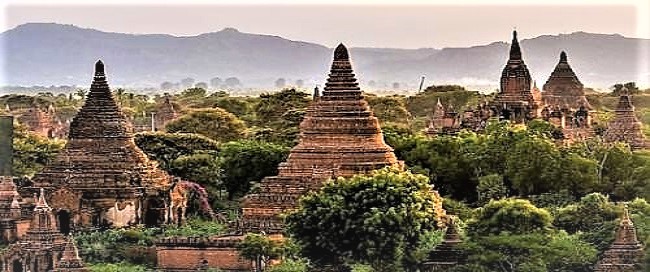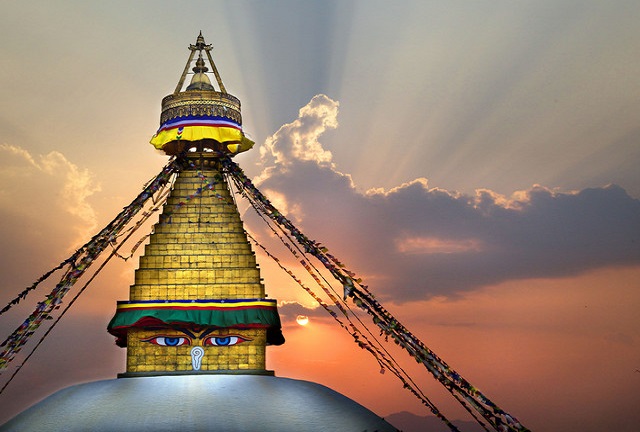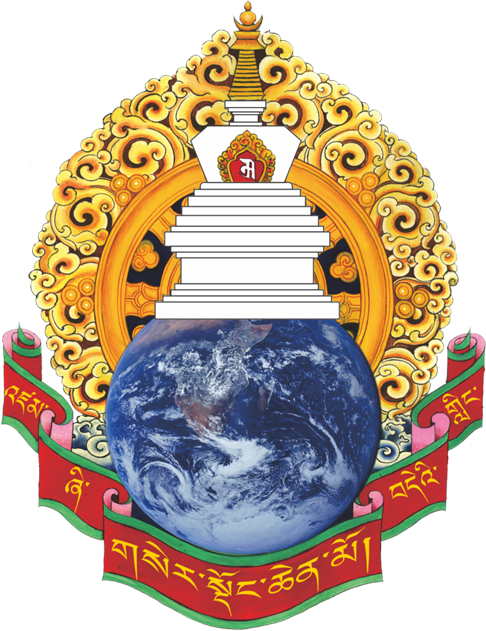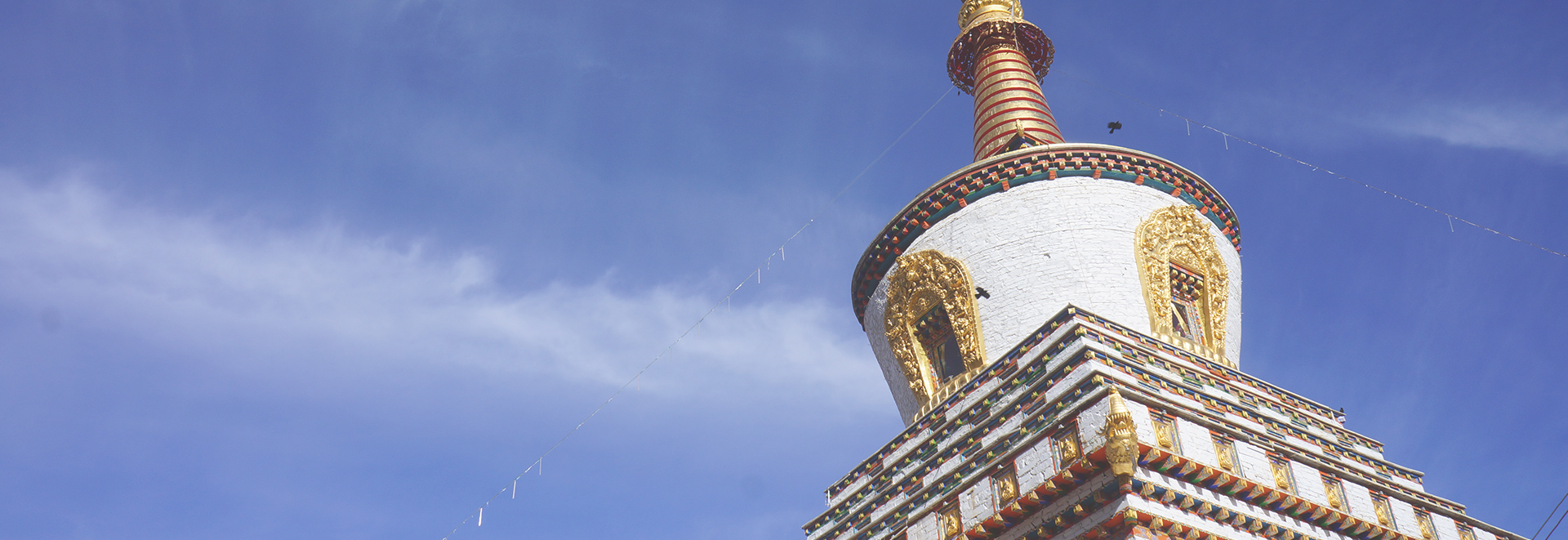Development
HISTORY
A specific explanation of how stupas first developed in the holy land of India as a part of the current Buddhist doctrine of Buddha Shakyamuni, the categories of stupa, and how stupas originated in the land of Tibet
A. From the perspective of definitive truth, our Teacher, Buddha Shakyamuni, the Capable One, was fully enlightened many aeons ago. However, in the common perception of beings to be tamed, Buddha revealed the twelve deeds here in this realm and matured unfathomable numbers of beings. At that time, in the auspicious grove of Lumbini, amid ten million wondrous signs, Buddha displayed the extraordinary deed of taking birth. Conjointly, in order to remember these special signs, extraordinary supports or receptacles for offerings were built. These were later called “stupas,” and they became universally known. As it says in the Sutra that Describes the Law of Karma (las kyi mtha’ brjod pa’i mdo):
In order to display the past deeds of the Nirmanakaya,
Sacred relics were housed in the eight stupas.

B. There are numerous categories of stupa belonging to the current Buddhist doctrine, such as the eight styles of Shakyamuni stupa (shak thub mchod rten) [aka Tathagata stupa] and the eight styles of sacred relic stupas (sku gdung mchod rten).
As for the eight styles of Shakyamuni [or Tathagata] stupa, they originated during the time of the Buddha and varied depending upon the construction methods of particular individuals.
- When Buddha was born in the city of Kapilavastu, his father, King Shuddhodana, and other members of the Shakya clan constructed the Heaped Lotuses Stupa (pad spung mchod rten), which is round and shaped like a lotus, symbolizing being born in the mud of samsara yet being untouched by that mud. It has four, seven, or even eight upper tiers and is adorned with lotuses and wheels.
- When Buddha attained perfect Buddhahood beneath the Bodhi tree on the full moon day of Vaishaka (Saga Dawa), Suncata and others in the kingdom constructed the Enlightenment Stupa, which is rectangular with four upper tiers.
- When Buddha turned the Wheel of Dharma of the Four Noble Truths in the region of Varanasi, the Five Excellent Disciples constructed the Stupa of Many Auspicious Doors, which is square with four upper tiers, each with a central extension, and one-hundred-eight or fifty-six or sixteen doors.
- When Buddha displayed great miracles in Shravasti in order to tame the six factions of tirthika teachers, Licchavi and others built the Tirthika Defeating Stupa, also known as the Great Miracle Stupa, in Dzeta Grove. It is square with four upper tiers and a central extension on each side.
- When the Buddha traveled to the Heaven of the Thirty-Three (Triyastrimsa) for the summer-rains retreat in order to teach his mother, and having done so descended from the heavens and returned to the human realm in the afternoon of the twenty-second day of the ninth lunar month after performing the gag-yé ceremony to release the retreat that morning, the faithful people of Sankissa constructed the Stupa of the Heaven of the Thirty-Three, renowned as Descent from Heaven. It has four or eight upper tiers, and on each side has a central extension with steps up the middle.
- When Shariputra and Maudgalyayana reconciled the schism that Devadatta had incited, which had split Buddha’s retinue into two factions, Jeta and other Magadha residents constructed the Reconciliation Stupa, which was square with four upper tiers.
- When Buddha granted the blessing of extending his life by three months in response to a supplication from his lay devotee, Chunda, after the king of maras, Mara Garab Wangchuk, requested Buddha to pass away, the inhabitants of Vaishali constructed the Blessing Stupa or the Stupa of Complete Victory.
- When the Buddha’s direct disciples’ good fortune was exhausted and Buddha passed into parinirvana in Kushinagar, the Malla people built the Nirvana Stupa, which has a tier-less raised seat that supports everything including the vase-base.
As it says in the Sutra that Embraces All Roots of Virtue:
There are, for example, tathagata stupas built [to commemorate] the turning of the Wheel of Dharma, or the attainment of manifest Buddhahood, or the defeat of mara beneath the Bodhi tree, or the great miracles of the Tathagata, or the perfect display of the Tathagata’s great parinirvana, or the descent from heaven, or the perfect ascent to the heavenly realms.
Desi [Sangye Gyatso] has said that they feel that this text is missing a line, since the Stupa of Heaped Lotuses is not mentioned. The prophecies of Khotan clearly state that there are, in fact, eight [tathagata] stupas.
Additionally, there are eight sacred relic stupas. When the Buddha passed into parinirvana beneath two Sal trees in the city of Kushinagar in Malla Country, his relics were divided into eight portions. The first portion is housed inside a stupa built by the Malla people in Kushinagar. The second portion is housed inside a stupa built by the Malla people in Yuldikpachen (yul sdig pa can). The third portion is housed inside a stupa built by Ksatriya Buluka in Allakappa (yul rtog pa g.yo ba). The fourth portion is housed in a stupa built by Ksatriya Krodtya in Ravana (sgra sgrogs). The fifth portion is housed in a stupa built by Brahmanas in Vishnudvipa (khyab ’jug gling). The sixth portion is housed in a stupa built by the Ksatriya Sakyas in Kapilavastu (yul ser). The seventh portion is housed in a stupa built by the Licchavis in Vaishali (yangs pa can). The eighth portion is housed in a stupa built by King Ajatasatru in Magadha. These eight are known as the famous Eight Reliquary Stupas.
Furthermore, the above-mentioned Shakyamuni stupas are a division of the nirvana stupa. Others include [a stupa containing] the golden vase into which the relics were placed, built by the Brahmin Drewo in Drewo Nyampa’i Yul, and [a stupa containing] the charcoal used to burn the body placed in the stupa built by the Brahmin Nyegrodha in his homeland, for a total of ten. As it says in the Minor Vinaya Scripture (phran tshegs),
At that time, in the world, there were eight Tathagata reliquary stupas, and the Vase Stupa made nine, and the Charcoal Stupa made ten.
And:
Of the eight reliquary vessels bearing eyes,
Seven were worshipped by worldly persons.
Moreover, according to prophecies spoken by Buddha himself, Dharma King Ashoka built ten million stupas to ornament the world and so on. While there are elaborate descriptions of the ways in which individuals constructed stupas found in sources such as the twenty-eighth chapter of the Sutra of One Hundred Karmas (mdo sde las brgya pa) and the forty-second chapter of the Nirvana Sutra (myang ’das), I will not include them here.



